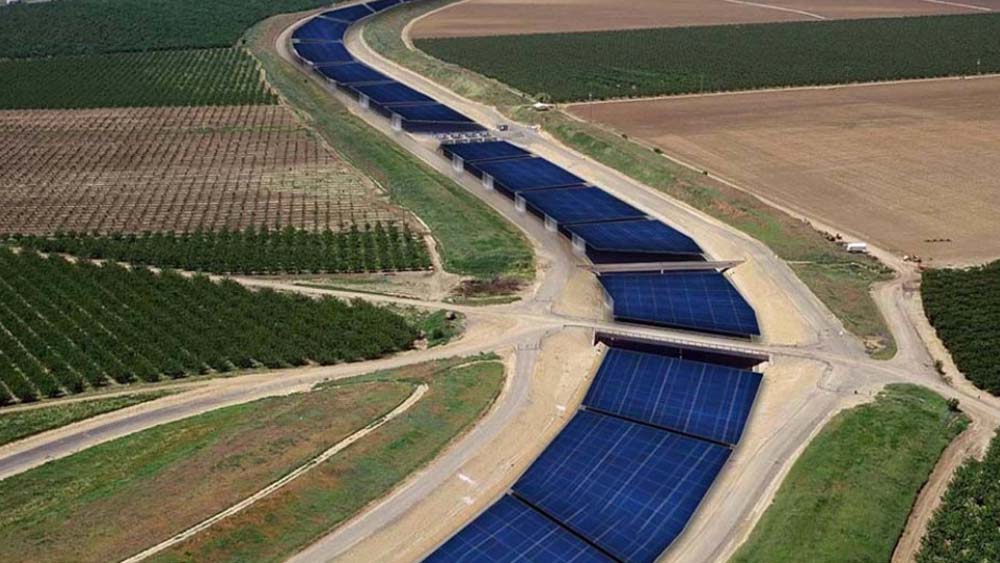From pv magazine USA
The three projects will receive a combined $19.5 million to support the projects, which are administered by the Bureau of Reclamation, an agency tackling the challenges of water and power management in the western United States.
This IRA carve-out was created with input from California Representative Jared Huffman. The program directed to study the water efficiency gains from covering canals with solar panels.
Solar on canals is a use-case for photovoltaics that is expected to come with significant co-benefits for each technology. The panels provide shade for the water resources, reducing losses from evaporation. In turn, the water cools the solar panels, reducing operating temperature, which improves the efficiency of the panels and slows degradation of the equipment.
“Deploying solar panels on our canal systems is a smart solution to our growing water and energy dilemmas – it harnesses clean energy technology to increase efficiency while reducing our carbon footprint and water loss from canal evaporation,” said Huffman.
The largest of the three projects, located in California, received $15 million through the fund. The San Luis & Delta-Mendota Water Authority will deploy floating solar arrays on the Delta-Mendota Canal. The University of California-Merced will study the project through a public-private partnership.
Researchers will deploy up to three varying floating solar technologies to assess the viability, costs, and benefits of floating solar over canals. The program will validate designs for PV on moving water and explore design and operational challenges associated with the emerging use-case.
Popular content
A 2021 study conducted at the University of California, Merced and University, Santa Cruz, showed that covering the approximately 4,000 miles of public water delivery system infrastructure in California with solar panels can generate 13 GW of energy annually, equal to about one sixth of the state’s installed capacity and about half the projected new capacity needed to meet the state’s goal of reducing greenhouse gas emissions 40% by 2030.
The study modeled that 63 billion gallons of water could be saved annually by covering canals, which is enough to irrigate 50,000 acres of farmland or meet the water needs of more than 2 million residents.
The two other pilot projects are in Oregon and Utah. A $2.55 million-funded project in Oregon will float solar panels on the main canal of the Deschutes Project near Bend, Oregon.
In Utah, $1.5 million in funds are diverted to a project on the Layton Canal near West Haven, Utah. The five-year demonstration project will collect data on technical capabilities and economic feasibility for deploying solar canals at large scale.
In addition to improving PV performance and reducing evaporation, solar on canals is expected to minimize canal maintenance by reducing aquatic plant growth, create land use savings and preserve agricultural lands, and reduce the energy and carbon footprint of water reclamation facilities.
Through the Bipartisan Infrastructure Law, the Bureau of Reclamation is also investing $8.3 billion over five years for water infrastructure projects, including rural water, water storage, conservation and conveyance, nature-based solutions, dam safety, water purification and reuse, and desalination.
This content is protected by copyright and may not be reused. If you want to cooperate with us and would like to reuse some of our content, please contact: editors@pv-magazine.com.



5 comments
By submitting this form you agree to pv magazine using your data for the purposes of publishing your comment.
Your personal data will only be disclosed or otherwise transmitted to third parties for the purposes of spam filtering or if this is necessary for technical maintenance of the website. Any other transfer to third parties will not take place unless this is justified on the basis of applicable data protection regulations or if pv magazine is legally obliged to do so.
You may revoke this consent at any time with effect for the future, in which case your personal data will be deleted immediately. Otherwise, your data will be deleted if pv magazine has processed your request or the purpose of data storage is fulfilled.
Further information on data privacy can be found in our Data Protection Policy.